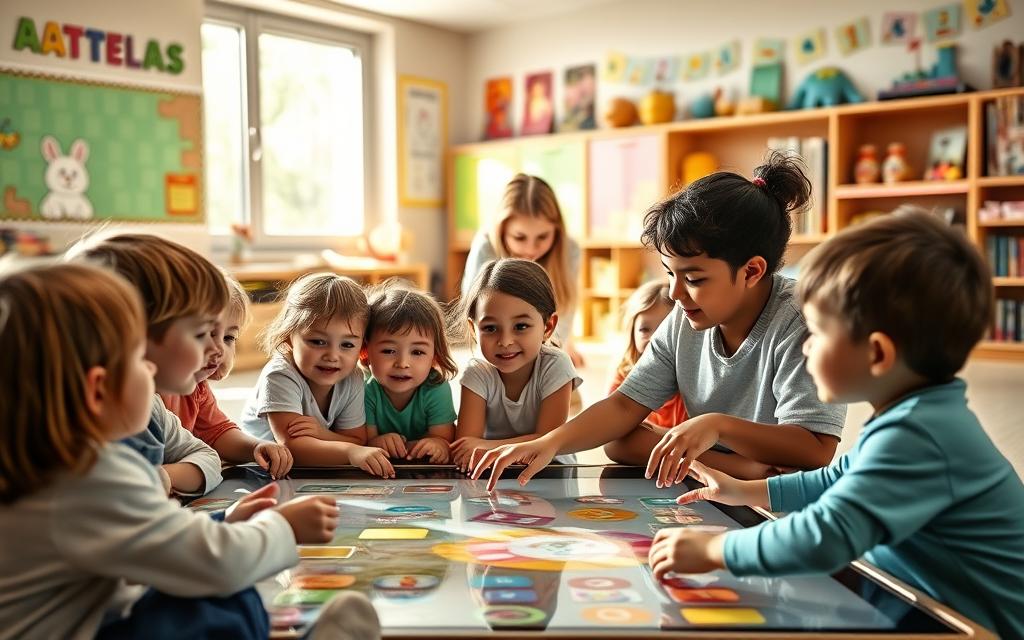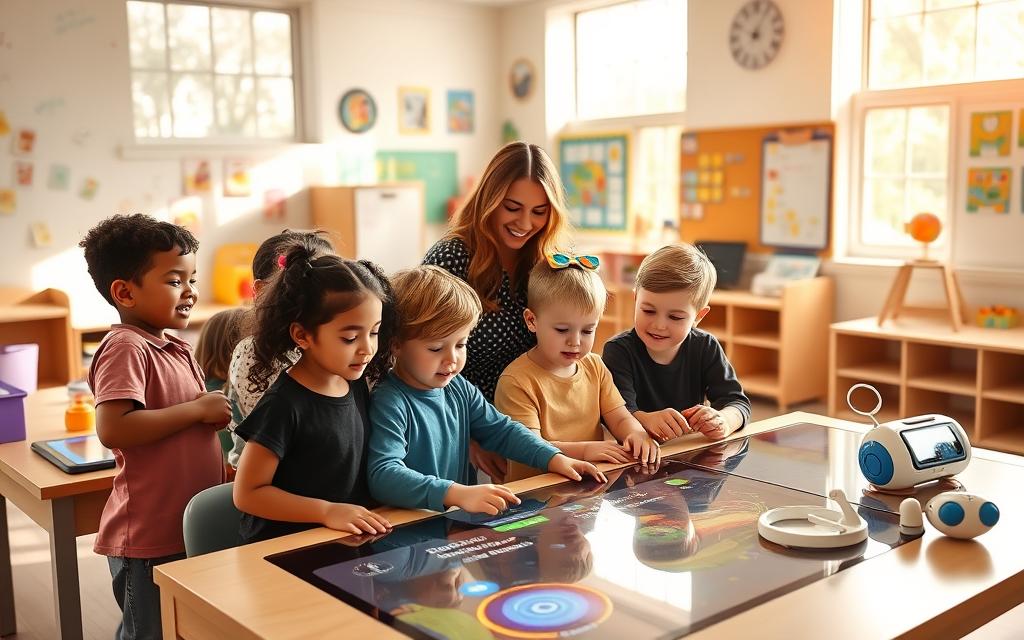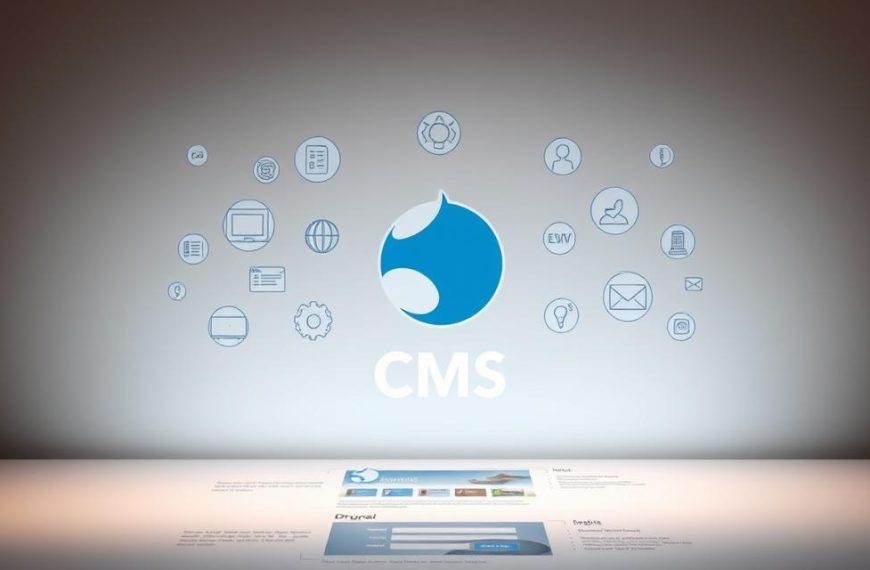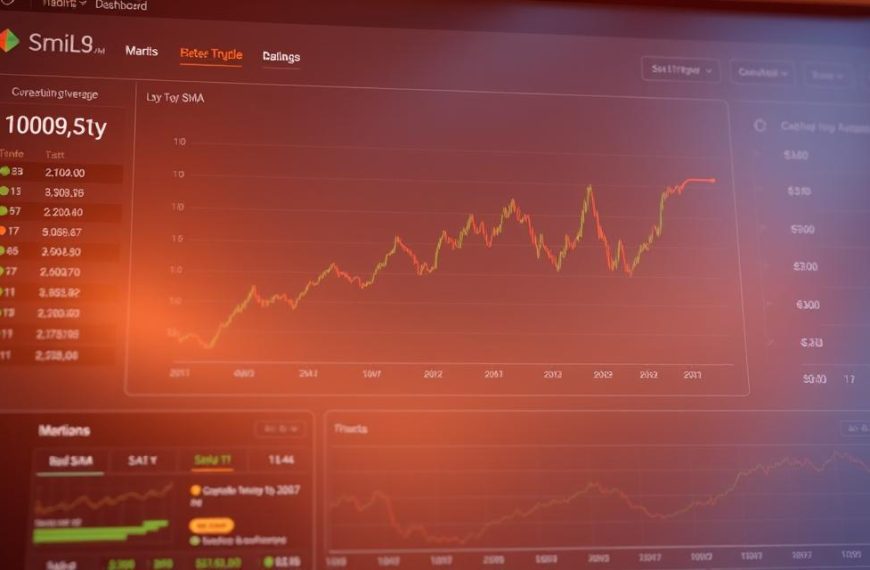Digital learning is reshaping early childhood education. It offers exciting opportunities and challenges for educators and parents1.
Preschoolers often arrive at school familiar with tablets and smartphones. This early exposure requires balanced educational strategies1.
The American Academy of Pediatrics advises limiting digital media use for young children. They suggest no more than one hour daily for ages 2 to 52.
Educational apps can support learning when used strategically. They should complement, not replace, traditional developmental activities2.
Modern preschools are using technology to boost engagement and digital literacy. Interactive whiteboards and educational apps are creating dynamic learning spaces1.
The key is choosing age-appropriate digital tools. These should enhance, not substitute, hands-on learning experiences. Technology should support critical developmental interactions.
Understanding the Role of Technology in Early Education
Digital tools are reshaping early childhood education. They offer exciting opportunities and challenges for educators and parents. Young learners now engage with technology that transforms their educational experiences3.
Technology has become crucial in early learning. Over 90% of U.S. preschool classrooms use some form of educational technology4. This digital revolution brings both promise and complexity to early childhood education.
Exploring the Digital Learning Landscape
The digital landscape in preschools includes various technological approaches:
- Interactive educational apps designed for personalised learning3
- Adaptive learning software tailoring content to individual learning styles3
- Digital storytelling tools enhancing communication skills3
Impact on Early Childhood Development
Technology offers many benefits, but careful implementation is crucial. Research shows excessive screen time may compromise developmental milestones4. Educators must balance digital engagement with traditional learning experiences.
Technology should be a tool for learning, not a replacement for human interaction.
Benefits and Challenges of Digital Integration
Educational platforms can bridge learning gaps and prepare children for a digital future3. Continuous evaluation of technological tools is essential for meaningful educational experiences3.
Preschools can harness technology’s potential by maintaining a balanced approach. This helps mitigate risks associated with early digital exposure4.
Essential Guidelines for Technology Implementation
Careful planning is key when bringing technology into preschool classrooms. Digital learning should balance with traditional methods. Technology ought to enhance, not replace, hands-on educational experiences5.
Screen time statistics reveal a pressing need for controlled technology use. Children spend about seven hours daily with screen media. Under-twos consume one to two hours5.
Most parents report electronic media exposure for young children. This highlights the need for clear preschool technology guidelines5.
- Limit daily screen time for preschoolers
- Choose age-appropriate educational content
- Integrate technology as a supplementary learning tool
- Monitor children’s digital interactions
Research shows risks linked to excessive media use for preschoolers. These include language development issues and reduced creative play. Social interactions may decrease, and attention-related problems might arise5.
- Language development challenges
- Reduced creative play
- Decreased social interactions
- Potential attention-related issues5
Professional learning is vital for effective technology integration. Teachers who receive dedicated tech training can develop better digital learning practices6.
The aim is to create engaging digital experiences. These should support children’s cognitive and social growth.
Technology should be a window to learning, not a barrier to exploration.
Smart preschool technology guidelines can transform digital tools. They become powerful educational resources that complement traditional learning approaches.
Choosing Age-Appropriate Digital Tools
Selecting digital tools for preschoolers requires careful thought about educational value and child development needs. Age-appropriate technology can transform learning experiences when used wisely7. Educational apps offer unique ways to engage young children and support their individual learning styles7.
https://www.youtube.com/watch?v=wOhb4n4ADbM
The digital landscape for early education offers many innovative solutions for young learners. Digital tools can enhance learning in various ways.
- Support personalised learning experiences7
- Facilitate collaborative skill development7
- Enhance creativity through interactive platforms7
Interactive Whiteboards and Smart Displays
Interactive whiteboards create dynamic learning environments that captivate children. These technologies allow for multimedia engagement and collaborative learning7. Smart displays help teachers design interactive lessons that encourage active participation8.
Tablets and Educational Apps
Tablets offer versatile learning platforms for preschoolers. Carefully selected educational apps can boost cognitive development and skill acquisition7.
Parents and educators should choose apps that:
Child-Friendly Computing Devices
For preschoolers, computing devices should be durable and age-appropriate. They need to be robust, easy to use, and have child-safe interfaces8. The International Society for Technology in Education suggests developing basic tech skills by age 58.
Technology should enhance, not replace, traditional learning experiences.
How to Use Technology in Preschool Classrooms?
Preschool tech integration needs careful planning. Digital activities should inspire curiosity and creativity in young learners. The aim is to make technology an engaging learning tool9.
Educators can use digital tools creatively:
- Use interactive whiteboards for collaborative learning activities9
- Encourage children to document daily experiences using cameras and video equipment9
- Create project-based learning opportunities through digital platforms
Preschool tech use has changed greatly in 20 years. Today’s teaching tools were once just computer stations10. During COVID-19, all teachers in lab preschools switched to new tech methods10.
Communication apps are vital in modern classrooms. ClassDojo and photo-sharing sites let teachers share children’s work instantly10. Virtual meetings can connect students with experts, boosting learning experiences10.
The goal is not to replace traditional learning but to enhance educational experiences through strategic digital integration.
Preschools can use tech to build key skills. A balanced approach keeps children engaged and motivated9.
Balancing Screen Time with Traditional Learning Methods
Screen time in preschool requires careful consideration. Parents and educators must balance tech use with traditional learning. A whopping 85% of parents worry about their children’s digital exposure.
Balanced digital learning means using technology wisely. Innovative educational approaches can turn screen time into valuable learning opportunities.
Setting Appropriate Time Limits
Clear boundaries are vital for healthy tech use. Experts suggest these guidelines:
- Limiting daily screen time to age-appropriate durations11
- Monitoring content quality and educational value12
- Ensuring diverse learning experiences
Integrating Technology with Hands-on Activities
Creative tech use can boost learning. Children can develop skills through purposeful digital engagement. These include video editing, storytelling, and interactive problem-solving12.
About 60% of early childhood educators favour active tech interaction over passive consumption11.
Creating a Balanced Learning Environment
The aim is to use technology to support traditional learning. Studies show tech-savvy kids improve critical thinking by 50%11.
Educators can enhance learning by choosing age-appropriate, quality digital resources12. This maintains a well-rounded approach to education.
Supporting Social Interaction Through Technology

Technology offers brilliant chances for collaborative digital learning in preschool classrooms. Children can build tech-enhanced social skills through well-planned digital experiences. These experiences encourage interaction and teamwork, as shown by fascinating research findings.
Preschoolers show significant social engagement when using technology together. A study found 12% of children played cooperatively using a multi-touch table. By 2014, 38% of children under two had already used tablets or smartphones.
- Collaborative digital activities encourage communication
- Shared technology experiences promote teamwork
- Interactive digital tools support peer learning
The classroom setting is vital for fostering tech-enhanced social skills. Research shows teachers can create environments where digital tools spark social interaction. One study found teachers in 10 preschools allowed computer use during free choice time.
| Technology Interaction Type | Percentage of Children |
|---|---|
| Cooperative Play | 12% |
| Parallel Play | 3% |
| Educational Game Participation | 43% |
Educators can turn technology into a powerful platform for social learning. By using digital tools wisely, they can avoid isolation and boost interaction among children13.
Teacher’s Role in Technology-Enhanced Learning
Digital education has revolutionised early childhood learning. Teachers now play a crucial role in integrating technology. They must balance traditional methods with innovative technological approaches14.
Facilitating technology use in preschool requires a strategic approach. Educators must carefully navigate the digital landscape. They ensure technology supports learning without becoming a distraction15.
Professional Development Requirements
Modern educators must develop skills to integrate digital tools effectively. Key areas of professional development include:
- Understanding age-appropriate digital learning technologies
- Learning to scaffold technological experiences for young learners14
- Developing strategies for meaningful technological engagement
Facilitating Digital Learning Experiences
Teachers guide children’s technological exploration. As partners and mediators, educators help develop critical thinking skills. They use interactive digital tools to enhance learning15.
Monitoring and Assessment Strategies
Effective technology integration requires robust monitoring techniques. Preschool educators should:
- Track individual student progress through digital platforms14
- Use technology to capture learning milestones
- Provide personalised feedback and support15
The future of early childhood education lies in thoughtful, intentional technology use that enhances learning experiences while maintaining a human-centred approach.
Safety and Security Considerations
Secure digital learning for preschoolers needs a thorough approach to online safety. Educators must protect young learners while introducing them to digital tech16. Early years are vital for teaching responsible technology use.
- Implementing age-appropriate filtering systems16
- Developing clear technology usage guidelines
- Protecting children’s personal information17
- Monitoring digital interactions carefully
Preschools must prioritise secure digital learning by setting up safety protocols16. This includes regular staff training and updating safety policies. Proper tech safeguards should also be in place18.
Parents and teachers should work together on digital safety. Continuous conversations about online risks and responsible technology use are essential18. Teaching children about digital boundaries helps them develop crucial safety skills.
Protecting young learners in digital spaces requires vigilance, education, and proactive strategies.
Practical tips for online safety include:
- Conduct annual online safety training for staff16
- Use child-friendly technological platforms
- Implement two-factor authentication17
- Regularly review and update safety protocols
The aim is to create a safe digital space that supports learning. This balanced approach protects children from potential online risks18.
Measuring Learning Outcomes with Digital Tools
Digital assessment in preschools uses advanced tech to track children’s progress. These tools offer new ways to monitor development across various areas. Studies show digital methods can provide detailed insights into how children learn.
Digital platforms have a small but important positive effect on learning outcomes. They can assess academic skills, social communication, and individual growth. Some preschool programmes using digital evaluation have shown lasting benefits through eighth grade.
Comprehensive strategies use various digital tools for assessment. These include interactive quizzes, digital portfolios, and observation platforms. Advanced tech allows for more personalised evaluation of children’s progress.
Educators can use these tools to create detailed records of a child’s learning journey. This approach captures subtle developmental changes that might be missed otherwise.
However, more research is needed on digital assessment in early education. It’s important to balance tech-based methods with traditional observation. This combination gives a full picture of a child’s development1920.
FAQ
At what age is it appropriate to introduce technology in preschool settings?
How much screen time is recommended for preschool children?
What are the potential benefits of technology in early childhood education?
How can educators ensure technology use is safe for young children?
Can technology replace traditional learning methods in preschool?
What types of digital tools are most suitable for preschool classrooms?
How can technology support social interaction among preschoolers?
What professional development do teachers need for technology integration?
How can learning outcomes be measured with digital tools?
What challenges might arise when introducing technology in preschool settings?
Source Links
- https://www.athenacareers.edu/how-to-integrate-technology-into-your-preschool-classroom/
- https://www.procaresoftware.com/blog/how-to-use-technology-in-preschool-classrooms/
- https://www.parent.app/blog/technology-in-early-childhood-education
- https://ren-network.com/education-technology-in-early-childhood-education-the-opportunities-and-challenges/
- https://highscope.org/wp-content/uploads/2018/08/162.pdf
- https://www.edc.org/sites/default/files/uploads/ApplePreKReport.pdf
- https://www.nurseryinabox.com/enhancing-child-learning-with-digital-tools-a-comprehensive-guide/
- https://www.naeyc.org/files/naeyc/file/positions/ps_technology_web2.pdf
- https://www.lillio.com/blog/5-ways-to-use-technology-in-a-preschool-classroom
- https://www.naeyc.org/resources/pubs/tyc/winter2022/technology-integration
- https://rockfoundationpreschool.com/the-role-of-technology-in-early-childhood-education-balancing-screen-time/
- https://raisingchildren.net.au/school-age/school-learning/learning-ideas/screen-time-helps-children-learn
- https://scholarworks.umf.maine.edu/cgi/viewcontent.cgi?article=1015&context=ech_projects
- https://www.tryplayground.com/blog/preschool-classroom-technology-role
- https://www.edutopia.org/article/using-technology-to-enhance-early-childhood-education/
- https://www.gov.uk/government/publications/safeguarding-children-and-protecting-professionals-in-early-years-settings-online-safety-considerations/safeguarding-children-and-protecting-professionals-in-early-years-settings-online-safety-considerations-for-managers
- https://www.edutopia.org/article/teaching-students-cyber-safety/
- https://learning.nspcc.org.uk/online-safety/online-safety-for-schools
- https://pmc.ncbi.nlm.nih.gov/articles/PMC9918405/
- https://www.mdpi.com/2071-1050/15/2/1305/pdf











